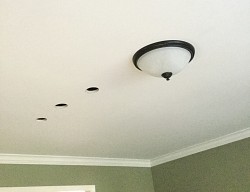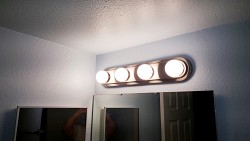The Difference Between Amps and Volts
 When dealing with electricity, many people find the difference between amps and volts confusing, and they often have trouble understanding the purposes of each. In this article, we look at the differences between the two and give you a better understanding of how they apply to the various appliances in your home. We also touch briefly on how to operate appliances safely and avoid sometimes-dangerous circuit overloads.
When dealing with electricity, many people find the difference between amps and volts confusing, and they often have trouble understanding the purposes of each. In this article, we look at the differences between the two and give you a better understanding of how they apply to the various appliances in your home. We also touch briefly on how to operate appliances safely and avoid sometimes-dangerous circuit overloads.
Amps x Volts = Watts
Let's establish, in layman's terms, how volts and amps work: Imagine a hose. Amps are the water pressure running through the hose, and volts are the diameter of the hose. Watts would be the volume of water coming out of the hose. Simply put, Amps x Volts = Watts.
In the US, all residential homes are wired with a 110-voltage circuit for all minor electrical appliances (such as coffee makers and table lamps), and a 220-voltage circuit for major appliances like your clothes dryer, stove, and air-conditioning unit. Think of your major appliances as needing more power, so they require a larger "pipe" through which to operate.
Circuit Smarts
Keep this concept in mind when operating multiple appliances on the same circuit of your home's outlet system. In newer homes, a wiring circuit's general layout will typically be written alongside each circuit breaker on your circuit panel. With the implementation and enforcement of city and county building codes, having a correctly wired home is thankfully a more common occurrence than it was 30+ years ago.
For example, in a home built after 1990, each breaker is associated with a certain zone of a house – that is, kitchen and bath on one, bedrooms on another, etc. However, if you're blessed with the trials of an older home as I am, your wiring may not always make sense. For example, half of the outlets in my basement are wired to half of my kitchen, whereas the other half are wired to my kids' play area and the dining room.
That said, when someone plugs in a blow dryer and tries to watch TV at the same time in my house, lights will dim, if not go out completely. Circuit breakers are designed to handle the overload and "pop" if too much power is being conducted.
Pay Attention to Red Flags
If you start to notice an excess power draw when certain appliances are plugged in, this is a red flag. Either the wiring is bad or a circuit is overloaded somewhere. Don't allow this situation to persist; investigate and get it fixed. Treat your electrical appliances and wiring with respect. Keep them well maintained, adhere to power limits, and you'll go a long way toward keeping your home safe from fire hazards.
Safety First
Keep these facts in mind when using your toaster oven or microwave. They can help you to avoid hassles or complications, and prepare you to troubleshoot should things go awry. If you have any concerns about your circuit breaker or the power consumption of a circuit, don't hesitate to contact a licensed electrician. Remember the old saying: "better safe than sorry."
Looking for a Pro? Call us (866) 441-6648

Electrical Average Costs
Electricians Experiences

All Our New Home’s Electrical Work Done By One Skilled Contractor

Electrical Wiring For Our New Shed



